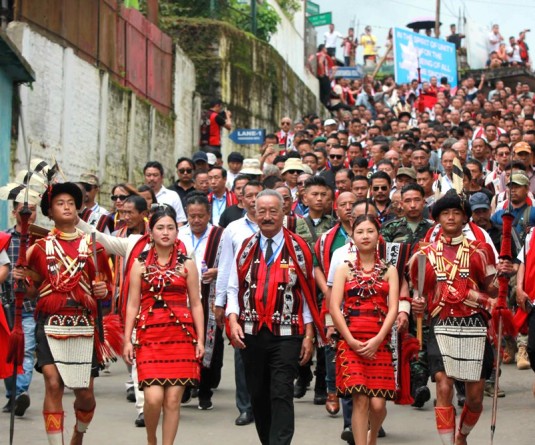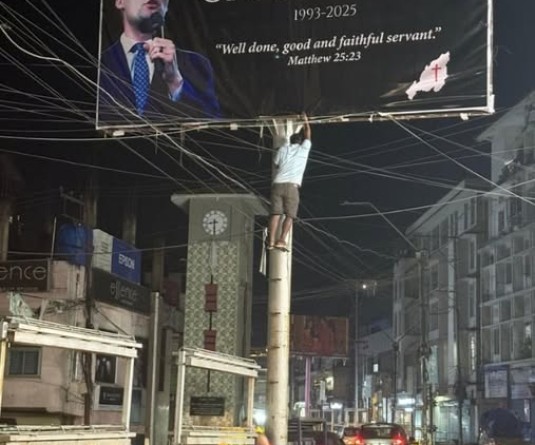
Dr. Somingam Mawon
I must tell this gentleman that today’s Tangkhul ‘social institution’ (read as traditional institution) is no longer an institution of the yesteryears: they have in a big way moved away from the past keeping in pace with time and space. What this retired Indian civil servant had in mind on the said institution is the picture of the pre-Christian Tangkhul society which in fact is a thing of the past. In practice, decision making for the community in this society no longer rests with the Chief or village council: instead, democratic means such as elections, consultations and discussions are widely practiced in almost all the Tangkhul villages. One of the prevailing trends vis-à-vis village administrations is the elections of village chairmen and village council members, and thus village Chief becomes a mere titular head. Further, some Tangkhul villages have a woman representation in the village council which, as of now, is nowhere found in other Naga communities. Correct me, if I am wrong! These are all indications of valuing democratic values and principles. In short, in an attempt to vomit out one’s frustration and intolerance let us not bring in traditional institution that would amount to misrepresent any community.
I have mentioned in one of my earlier pieces that one of the prevailing trends in our society is the ‘teaching’ on patriotism and nationalism after the retirements from the Indian government service sectors. By the way, this statement is not a mere criticism but rather a hard fact of the Naga society. Naga political history has shown that no political group, be it Naga National Council or NSCN, is free from the criticism of tribalistic functioning and governance within the organisation or the organisation is tribally profiled in their set-up. There is no Naga political group that is ‘proportionately’ represented by all Naga communities in the organisation. Instead, it is always one or two tribes that dominated the entire governance of the organisation. Further, since the days of A.Z. Phizo, in all Naga political groups there were and are always some leaders who ‘dictated’ the groups in their organizational affairs.
Like the cadres of the NNC (both living in and outside of the peace camps’ comfort zone) are primarily Angamis and Chakhesangs, one cannot deny the fact that many cadres of the National Socialist Council of Nagalim headed by Isak and Muivah are Tangkhuls and Sumis. Proportionate representations of all (an idealistic view) Naga tribes within the organisation is an important one, but what is more important and relevant is their ‘political capacity’ that could bring a logical conclusion to the Naga political movement. In other words, what the organisation could do for the whole Nagas is something to be measured. At times, like other organisations, Muivah and his close associated might have ‘dictated’ the terms and conditions in the governance of their organisation: but to compare Muivah with Kim Jong Un is not a rationale comparison, but rather an immature statement. Seriously, Kim Jong Un?
Indeed, if we go by the yardstick of artificial territories drawn by the colonial British and the Government of India, Muivah neither belongs to nor represents Nagaland state. In principle, Muivah and the organisation he represents is not fighting for the cause of the Naga people living in Nagaland state, but for the cause of all Naga people. The point is that if we cannot move out from this cocoon of ‘we’ and ‘they’ feelings among the Nagas of Nagaland, Manipur, Assam, Arunachal Pradesh, or Myanmar for that matter, there is no point of talking big on Naga nationalism. By the way, this was exactly what Nehru had designed and would have wanted the Nagas to fight among themselves on the line of these artificially drawn territories. All politically conscious Nagas know the ‘special constitutional provision’ given for Nagaland state. One would suppose that the most probable solution that is to bring shall have more ‘autonomy’ than the Article 371A of the Indian Constitution. Now the question is, will those Nagas who are contented with the said article as the solution to the Naga issue be ready to reject any solution that will recognise more ‘autonomy’ than this ‘special constitutional provision’? I don’t think so!
Many are confused about the term framework agreement, and thus equated it with the term accord. Put quite simply, if we do not know the meanings and differences of the said terms, who are we to talk about mechanisms of conflict resolution and management? In my understanding, the representatives of the conflicting parties at the negotiating table will definitely table the content for public deliberation once an accord is inked: and the interests of the Naga people must find its place in the accord in order to bring solution to the long drawn political conflict. In principle, if the accord that is to be brought is against the ‘core interests’ of the Naga people, then, either the other political groups initiate the talks or the Naga people resort to different mechanism in order to resolve their conflict. Until then, the Naga people need to be patience and the parties to political negotiations deserve such public support and a chance to deliberate on what they can deliver. For the Nagas, now is not a time to seed hatred or to ‘keep’ the probable political concepts in the ‘Museum’ (in the word of Thepfuhouvi Solo), but time has come to ‘pressurize’ the conflicting parties at talks to resolve the conflict and then present the outcome to the people. In a sentence, what the Nagas need today is not about who is right or wrong, it is about what is right for the future of the Naga people.
* The writer is currently a Firebird Foundation Fellow.






